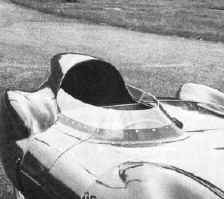
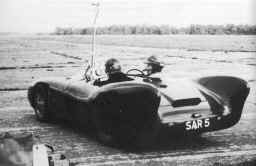
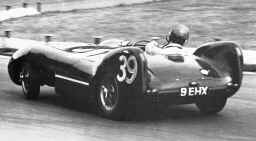

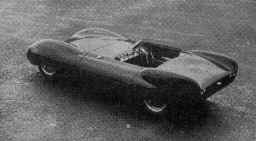
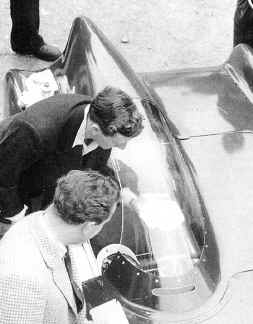
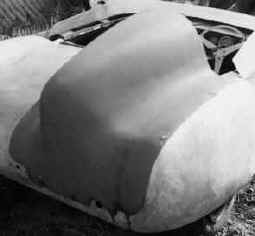
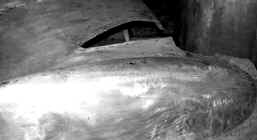
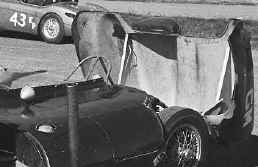
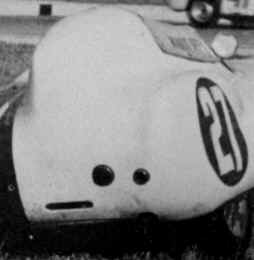
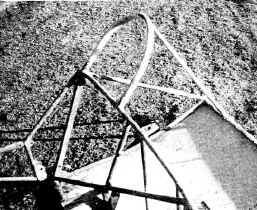
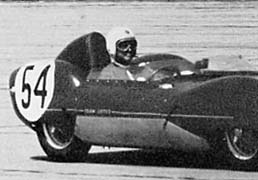
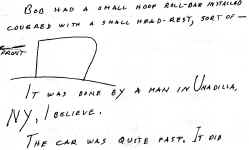
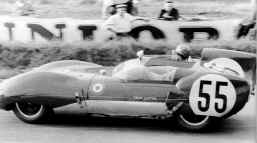
|
In the notes
about different types of windscreens used on the Lotus Eleven (Dark Ages
item # 15) mention is made of the single-seat cockpit configuration most
often associated with the car. This
single-seat cockpit is sometimes referred to as the “LeMans” body
configuration, usually a part of the LeMans package with disc brakes and
deDion rear suspension. It
is one of the most striking features of the Eleven and proved to be
very effective in any competition event in which it was permitted.
This was part of the Eleven’s
super-aerodynamic bodywork, drawn by Frank Costin, engineer for DeHavilland Aircraft and brother of Mike Costin, the unsung
hero of Lotus.
When Frank Costin began to adapt his aviation-inspired concepts to Lotus
racing car shapes, he took great pains to impart directional stability into
his designs. At the time racing cars were of course faster than road cars
but not necessarily better handling, with slippery tires and high drift
angles the norm. Safer
control of the car at high speeds became an obsession to him, at least
as important as creating a low-drag shape.
The pronounced tail fins on the Mark 8 & 9, for example, had
nothing to do with styling. Costin
simply felt that aerodynamic improvements to allow the car to travel
faster should also bring aerodynamic resistance to sidewinds, and help
the driver keep the car going where it was steered.
By late 1955 when the Eleven was being designed Costin again
incorporated a vertical stabilizer into the shape, although drag
reduction was now the main function. 1
This time the side fins had been reduced to mere trailing edges
of the wheel enclosures. But
there in the headrest was a tailfin more obvious than ever.
In keeping with the modular, street or race, nature of the Eleven
this “fin” could be removed. So
when the “Press Car” was unveiled in February 1956, body panels were
laid out on the ground. Potential
buyers couldn't miss: this
car could be driven with either the racy single-seat cockpit with its
dashing headfairing, or as an almost practical open two-seater with a low-profile
“boot.” The new rocketship for the road set many a young man’s
imagination afire.
In Dennis Ortenburger’s book on Costin, the single-seat bodywork is
called “ yet another pure aerodynamic shape to cover the driver. (Costin)
arrived at an elongated canopy and then sliced its top off half way back
to allow the driver to get in. What
remained in front of him and to the sides was perspex.
The aft section was formed in aluminum and although called a
headfairing it really wasn’t. In
Costin’s scheme the entire shape, windscreen and headrest, faired the
driver and tests showed that the air flow remained remarkably well
attached even above the actual opening.” 2
That pure shape is best illustrated with the “Monza” bodywork as
seen here.
Not every full-spec “LeMans” Eleven had the single-seat cockpit, and
some Elevens that did were not LeMans.
Many Elevens were delivered to their owners with full sets of
road and track screens and corresponding bodywork. The
factory called the single-seat addition a TOP KIT and it
was an option with the
purchase of any Eleven or body
chassis unit. There was a proviso of course: the center section and
passenger's door had to have a recess for the tonneau which would have
been hard to add afterwards -- plus the easy addition of Dzus fastener
clips. The aluminum headrest was only
attached to the tail section with Dzus fasteners, and so could be used
as needed. Whenever the
single-seat windscreen was removed in favor of a full-width ‘screen,
the headrest was usually removed too because it immediately became an
air brake without the forward half of Costin’s “canopy.”
Ironically, the single seat cockpit with headrest were never used on
the Elevens that raced at LeMans. In
that race a full width windscreen was required from 1956-on for cars
that were ostensibly “two-seaters.” The same was true in 1957 for
Sebring and wherever the Eleven raced under the rules of FIA appendix C.
Due to this regulations change, a higher percentage of Series-2
Elevens were delivered with the full width screen, and no headrest.
In American racing the single-seat configuration with headrest was far
more popular with buyers. Only
the SCCA requirement of a rollover bar caused a problem.
On the Eleven the easiest place to mount a rollbar was the rear
face of the seatback, with a reinforcement tube from the bar back
to the right-rear corner of the chassis.
This arrangement could be made to fit unseen under the headrest,
but aluminum had to be cut to make it work.
To open and close the tail section the headrest would first have
to be removed, revealing slots and holes in the upper bodywork to clear
the tubes. The example at left is
typical. A few clever
owners also modified the headrest so that the front face was removable,
to enable it to the clear the bar.
The factory solution may have been at the request of Jay Chamberlain,
and only for the American market.
Many years later Chamberlain recalled 3
that as so many buyers wanted the headrest, a request was made of the
factory to make it integral with the tail.
This is consistent with the factory announcement: In
view of the recent S.C.C.A. ruling, a crash roll bar will be fitted as
standard to the chassis and this is hidden inside the head fairing. In
order to supply this, of course, the head fairing must be part of the
tail and not removable. 4 In this setup the headrest was open into the rear compartment,
and so the entire tail could be opened or closed around a rollbar
without the need to cut anything. The
integral headfairing is rare enough in the USA, and almost impossible to
find elsewhere. In the photos
at left we may have some of the factory examples.
In any event, despite the
existance of a few integral headfairings, most Elevens continued to be
produced with the removable type.
This is a
good place to insert a photo of the factory rollbar and photos are all
we have of these today, as original examples were replaced as more stringent
standards went into effect.
Note that the rollbar on this early chassis is slanted back to allow clearance for the hinged
tail section, actually making it less effective in protecting the
driver.
The priority was clear. But Lotus may have made a change to the
frame design to better support the rollbar later (mid-1956)
by switching the seatback diagonal tube to the
driver's side. This
is speculation but it makes sense.
A few homemade
headrests found their way onto Elevens too, such as the one on Dave
Tallaksen's ex-Sebring car. The
sketch at lower left is one eyewitness' recollection of the unique addition to Bob
Bucher's Club model, raced in the Northeast USA in the early 60s. (Does anyone have more on the Bucher Eleven? )
Lotus shrank
the headfairings on later models, as on the 15, with minimal effect on
vertical stabilization and more on simply shaping the airstream around
the driver. Only a few 17s had headfairings, and the mid-engined
19, 23 and 30 had none, relying entirely on the windscreen to shape the
airflow. It had already been observed with the Eleven that stability was good with or without the headfairing. As
for shielding the driver, Lotus had shown with the '57 LeMans Elevens
that it could be done with careful shaping of the 'screen and a higher
seatback line. The headfairings on those cars seems less prominent
as a result. Those special cars for LeMans mark the last time
Frank Costin was involved with the shape of the Eleven.
1 At
this point, Grahame Walter's influence in the earliest stage of the
body shape and design should be mentioned. Walter had done wind
tunnel tests on scale models that showed the efficiency gained from
use of a headfairing. In 1955 Chapman invited Walter to the meeting where Frank Costin first drew the Eleven's shape. The
incorporation of a headfairing in the design was one of Walter's
suggestions. Chapman was especially excited with the idea
of a headfairing option and the profits from offering
additional bodywork. Similar headfairings had been seen on other
cars already, such as the Panhard 750cc speed record car as well as
the Jaguar D-type.
2
Flying on Four Wheels, Frank Costin and his car designs –
page 57
3
In response to a question from Russ Hoenig at the 11th
annual Lotus Owners Gathering (LOG 11) in 1991, held at Waterbury,
CT. USA.
4 From Sales Bulletin #1, June 1956 from Colin Bennett to all overseas
sales agents. |


